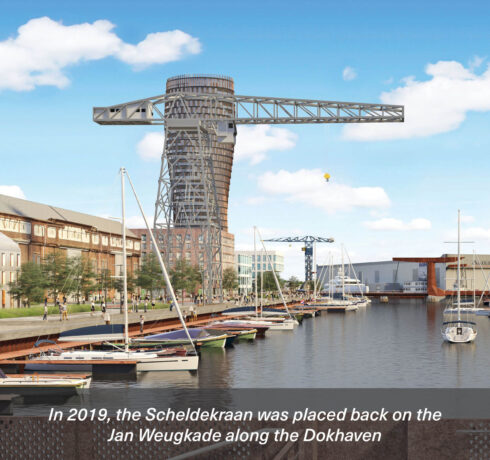“It will be a district with stories,” says John de Jonge, Vlissingen City Council Alderman, when talking about the Schelde Quarter, where so much construction is taking place that the city is undergoing a metamorphosis. Behind and just north of the Damen Naval headquarters, a completely new residential area is taking shape. The former beating heart of De Schelde around the Dokhaven is turning into an urban district that honours the memory of De Schelde’s industrial heritage. “Vlissingen is reinventing itself.”
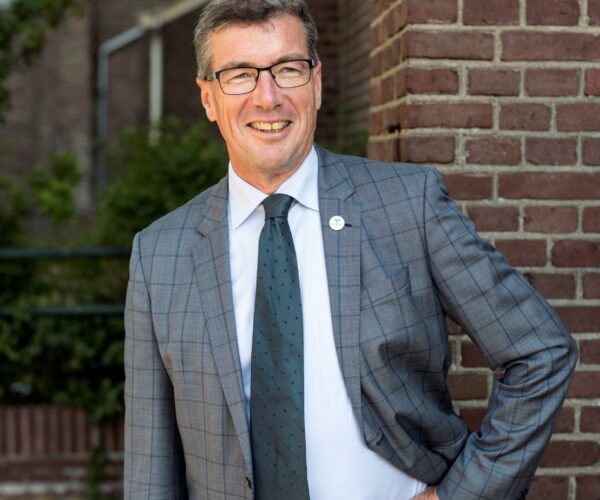 Vlissingen City Council Alderman John de Jonge. Photo: Mechteld Jansen.
Vlissingen City Council Alderman John de Jonge. Photo: Mechteld Jansen.
Damen Naval’s head office will soon have new neighbours. In the ‘Scheldewijk’ behind the office building, the new construction projects Broederband and De Vesting (bordered by Willem Ruysstraat, Van Dishoeckstraat and Paul Krugerstraat) are being built. There is a school and a small park also planned for the area. Streets are named after illustrious ships that De Schelde built for Royal Rotterdamsche Lloyd. This is part of the Schelde Quarter development project, which the Vlissingen City Council adopted at the end of 2016 and which is currently running at full steam.
The City Council’s Alderman De Jonge is pleased that Vlissingen is getting back on its feet thanks in part to the Schelde Quarter. Around five years ago, the Council was still struggling with the 40-hectare former industrial site of De Schelde shipyard that it had bought from Damen. The Council’s treasury funds were empty and the burden of debt was too high to invest in the area. The Dutch State was eventually willing to help the city reduce its debt burden by granting the Council Article 12 status in 2016. Since then, progress of the Schelde Quarter has gained momentum.
The alderman explains that the development of the area is divided into three subprojects. Around the Dok van Perry, a number of new construction projects have been carried out adjacent to the old city centre. These blend together nicely, connecting the old city, as it were, with the Dokhaven and its surroundings. This subarea has been christened ‘Schelde City’. The extensive site around the Dokhaven, which dates back to 1614 and was once the slipway for the seagoing vessels built by De Schelde, is changing into a robust urban district with the name ‘Scheldewerf’ where the memory of Vlissingen’s rich shipbuilding past will be cherished.
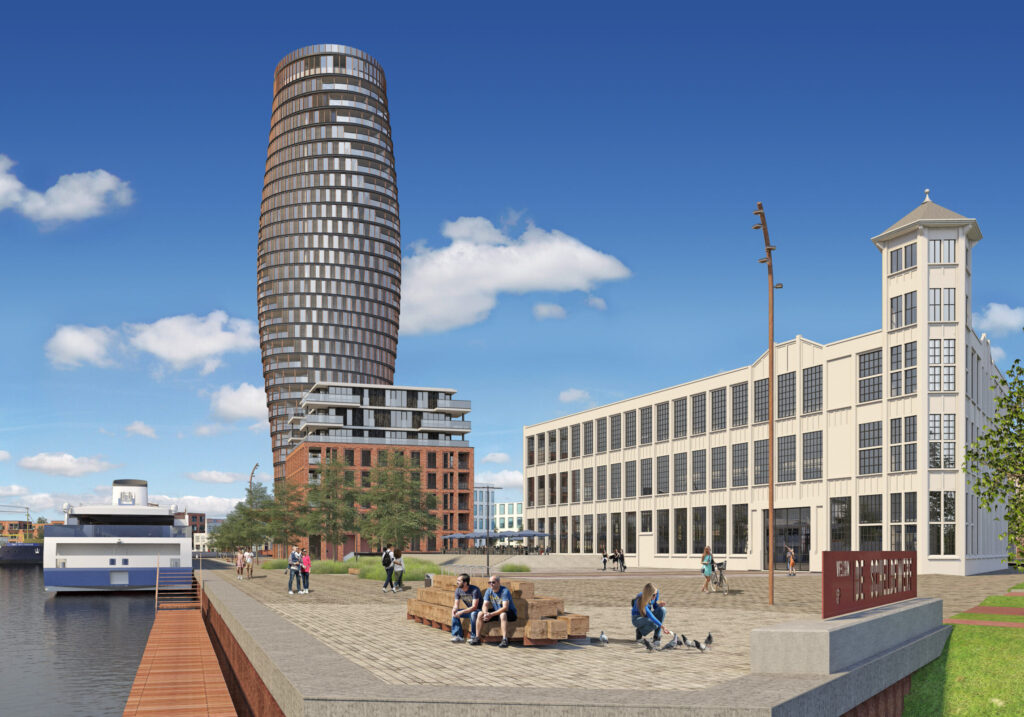 Artist impression of the Albionkade, with Hotel De Timmerfabriek and the 100m Zeelandtoren.
Artist impression of the Albionkade, with Hotel De Timmerfabriek and the 100m Zeelandtoren.
“We wanted to realise residential complexes there, such as the De Ketelmakerij project on the Jan Weugkade. These would be extensive, therefore fitting in nicely with the robust production buildings of the former Schelde. This way, we could make a link with the industrial history of the city,” says John de Jonge. The ‘Scheldewerf’ is, in his own words, ‘a tough area’, where in order to accentuate that toughness even further, stelcon plates instead of paving stones are being used in a number of places. “It is possible that, purely for decoration, parts of the Schelde train tracks will come back.”
"Vlissingen is reinventing itself. The people of Vlissingen are proud of their city again and want to show that to others. This is partly thanks to the developments happening in the Schelde Quarter." City Council Alderman John de Jonge
“An old De Schelde tower crane is already there, and the steam crane that was saved from the scrapyard by Wesley Sekewael’s organisation will also get a place there, near the Oude Verbandkamer where the Schelde Museum is. The Timmerfabriek, a listed building and the first concrete shell building ever built in the Netherlands, will be converted into a beautiful hotel with high ceilings and lots of light. Recreational apartments – part of the hotel – will be built next to the hotel, and a complex of luxury flats and penthouses, all of which have already been sold, will be built on the east side of the Timmerplein.”
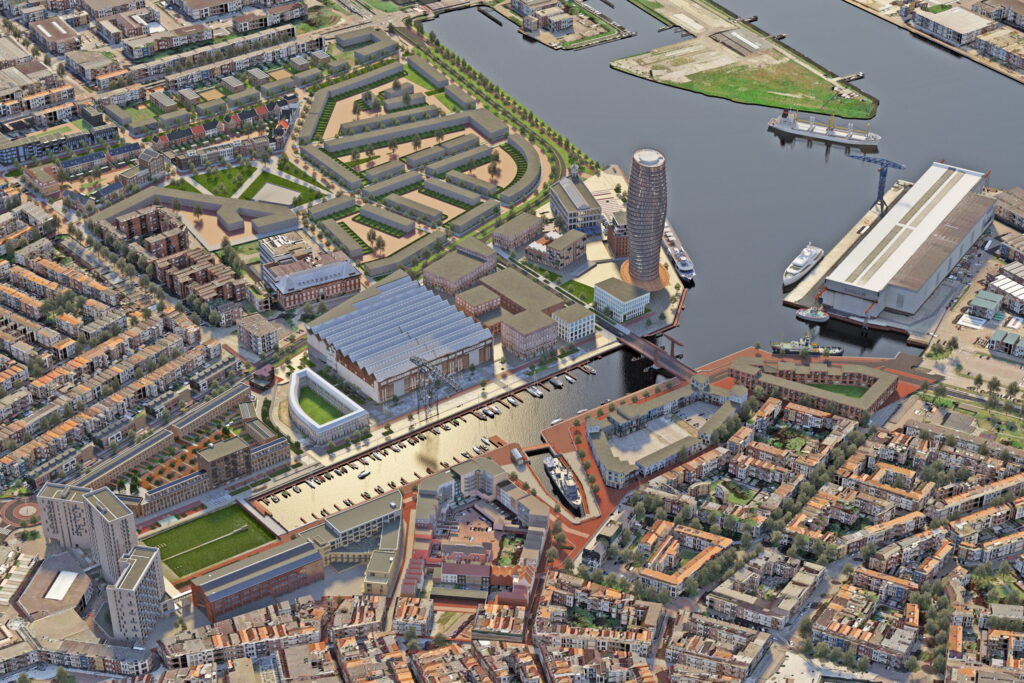 Artist impression of the Scheldekwartier as seen from above.
Artist impression of the Scheldekwartier as seen from above.
“The Scheldehof medical care centre – the former heavy steel workshop – still exhibits signs of the Schelde history both inside and out, in combination with its new functions. The imposing Machinefabriek will also remain, but this building will be repurposed for parking spaces for eight hundred cars. The ground floor of the Machinefabriek, which covers one hectare, will be kept open for public events to emphasise the liveliness of the area. The parking spaces are for, among others, Damen Naval employees whose current car park on De Willem Ruysstraat is making way for housing.”
To further emphasise the diversity of the Schelde Quarter, a marina will be created in the ‘Scheldewerf’ area of the historic dock. This will be commissioned in mid-August under the name ‘De Stadshaven’. The area under development between Willem Ruysstraat, Van Dishoeckstraat and Paul Krugerstraat forms the third branch of the Schelde Quarter development plan. This has been christened ‘Scheldewijk’. The residents of this new residential area will be the new neighbours of Damen Naval, whose monumental head office is directly adjacent to the area.
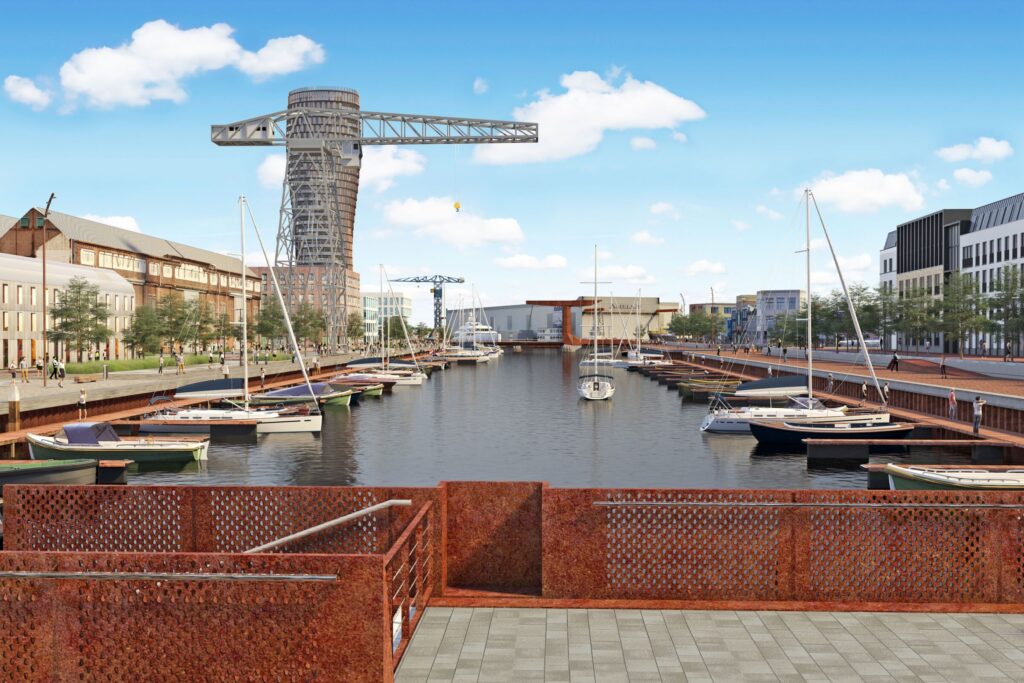 Artist impression of new marina De Stadshaven in Het Dok.
Artist impression of new marina De Stadshaven in Het Dok.
In the ‘Scheldewijk’, the Singel and Verkuijl Quakkelaarstraat will be extended towards the canal. As with the rest of the Schelde Quarter, housing in the ‘Scheldewijk’ targets all income groups, emphasises the Alderman. The Schelde Quarter should be completed by 2030. At that time, who will recognise Vlissingen as it was at the turn of the century? “At the end of the last century, De Schelde was on the verge of collapse. And at the beginning of this century Vlissingen was still having difficulties,” says John de Jonge. “The city has been through a lot but always comes back on top.”
“It is like the tide to which we have been accustomed for centuries; after a low tide there is always a high tide again… Vlissingen is reinventing itself. The people of Vlissingen are proud of their city again and want to show that to others. This is partly thanks to the developments happening in the Schelde Quarter. I remember when the Schelde terrain was a kind of Forbidden City. Do you remember how long it took to drive from the Keersluis Bridge to Het Eiland? Now that the new Dokbrug has been built, you can get there in no time. I am pleased that the Schelde Quarter is a lively part of the city once again. Vlissingen has her heart back.”
“But not everyone was immediately proud, you know… In 2019, when the Schelde crane was officially reinstated on the Jan Weugkade at the Dokhaven, a few people sat and grumbled. It’s all cost so much, they complained. But then the crane horn was sounded, and the handkerchiefs came out.”

